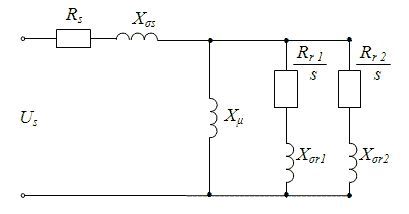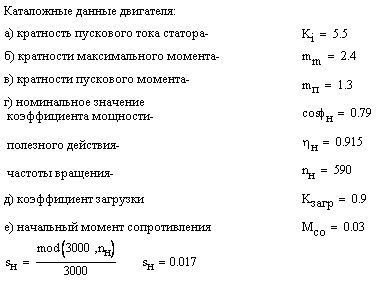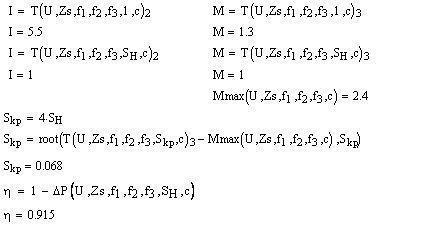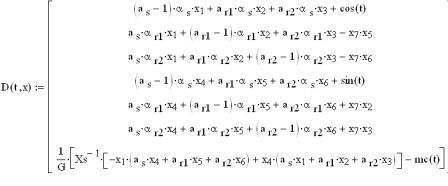
Shakhova Tatуana
Faculty: Electrotechnical (ETF)
Department: Electrical Power Plants (EPP)
Speciality: “Electrical Power Plants”(EPP)
Theme of master's work:
“Mathematical design of electromechanics
transients in the own needs systems for modern
sectional aggregates by power 200 MW”
Scientific supervisor: Dr.Sc., Prof.dep. EPP Vitaliy Sivokobylenko
| Autobiography | Abstract | Report on a search |
ABSTRACT
of the qualification master’s work
«Mathematical design of electromechanics transients in the own needs systems for modern
sectional aggregates by power 200 MW»
sectional aggregates by power 200 MW»
СONTENT
2 COMMUNICATION OF WORK WITH SCIENTIFIC PROGRAMS, PLANS, THEMES
3 THE PURPOSE AND PROBLEMS OF THE DEVELOPMENT
4 PROSPECTIVE SCIENTIFIC NOVELTY OF THE RECEIVED RESULTS
5 PRACTICAL VALUE OF THE RECEIVED RESULTS
6 APPROBATION OT THE WORK RESULTS
7 THE REVIEW OF DEVELOPMENTS AND RESEARCHES ON A THEME
8 THE MAIN CONTENT OF THE WORK
The rapid development of digital computers has facilitated the development of new methods of mathematical modeling and calculation of steady state and transient modes of operation of electrical and power systems. This has allowed a new approach to many issues of design and operation of various facilities. In general, the processes in the object can be described by analytical relations, which are based on a system of nonlinear algebraic and differential equations. In this case if there is information about the parameters of the system and topological relationships between its elements can be constructed a mathematical model of the object with which analyzes its behavior in various modes.
Currently used mathematical modeling, and have programs for electric modes, short-circuit currents, electric and magnetic fields. This information is used to optimize the design and management of electrical facilities. A reliable and economical operation of modern thermal power plants depends on the reliable operation of auxiliary mechanisms. Basic mechanisms of auxiliary power are asynchronous and synchronous motors 6 kV. The continuous increase in unit capacity units leads to an increase in the installed capacity of motor load, making it difficult to ensure a successful self-starting and dynamic stability of the engine load when a short circuit and short-term undervoltage. It can result in the emergency rejection of blocks of power-stations and lowering of reliability of functioning of all of grid on the whole.
Qualifying work of the master performed throughout 2009-2010. According to the scientific direction of the Department of “Electric Power Plants” of the Donetsk National Technical University.
With a view to improvement and development of multimachine power systems are considered required questions: development and creation of a mathematical model that allows to investigate the features of transients in the systems of their own needs modern modular units, calculation of stationary regimes, using the simplified equations Park Goreva analysis of dynamic and static stability of power units with the motor load. For achievement of the put purpose it is necessary to decide the followings basic tasks:
- create a mathematical model;
- investigate the transient processes taking into account the dependence of the parameters of displacement currents and saturation of magnetic circuits;
- use the methods of nodal voltages;
- create a set of algorithms and programs for the formation of different types of mathematical models based on complete or simplified equations Park Goreva or algebraic equations for the stationary regimes
The subject of the study are the methods and algorithms for simulation of mathematical model of transient processes in power plants.
A research object is a mathematical model of electromechanics transients of own needs of modern sectional aggregates.
Methods of researches. We used methods to improve the numerical integration and improve numerical stability of differential equations, method of structural modeling in the work.
Recently, due to the rapid development of computer technology, as well as due to increased demand for precision modeling in the design and creation of high-power systems, thermal power plants and other critical systems with large induction motors and synchronous motors have become increasingly interested in models of multimachine power systems. In connection with this scientific novelty consists at the mathematical modeling of electromechanical transients in the own needs systems for modern sectional aggregates. Topical is the creation of a universal model for studying both short and long processes in the group of machines based on their mutual influence, given the dependence of the parameters of the displacement currents and saturation of magnetic circuits. The mathematical model created in MathCAD environment 2001.
The mathematical model may have wide application not only in power stations, but in any enterprise that uses a large number of asynchronous motors, trouble-free operation which should provide trouble-free production, which is especially important for large enterprise of the Donbas.
April 27, 2010 participated in the conference on «the Day Science» at the Department of «Electric Power Plants». Report was entitled "Electromechanical transients occurring during the heating of the electric motor's own needs". The main feature of systems power supply its own needs is the application of power transformers and desktop backup with split low voltage winding, and application of asynchronous motors, high unit capacity (200-8000 kW), squirrel-cage rotor which runs from deep groove to improve the launch and performance by using the effect of displacement current.
At the present time to analyze the modes of power systems is widely applied mathematical modeling techniques. If do a local review , we find that many of the topics master work of our department are related to mathematical modeling. This is explained by the fact that the mathematical model plays an important role not only on power plants, but and in any enterprise. If the engine will run continuously, that will raising the potential of the Donets Basin, and then Ukraine. In a global survey, you will notice that many firms are engaged in development of mathematical modeling of transients. Here, for example, the program "Dynamics" is intended to simulate electromechanical transients in response to changes in the frequency of various switching and events occurring in the system and analysis of dynamic stability of the system [1].
Induction motors high voltage are performed with two cells or with deep groove rotor, that improve their starting characteristics. The parameters of these machines non-linear, due displacement currents in the rotor and the saturation paths for magnetic flux.
The advantage of multiple-equivalent circuits ac machines is the universality of their use for calculating the transient and steady-state modes [2].


The calculation of the parameters of a two-equivalent circuits of induction motor with engineering method [3].



1. Define inductive reactance of the stator scattering

2. Find the load current, which is taken to be equal to the current magnetization

3. We find the inductive reactance of the branch of the magnetization

4. Determine the input resistance of the engine at rated speed at Sн

5. Determine the input resistance of the engine start-up at S = 1

6. We find the conductivity of the rotor at rated slip

7. Accepted parameters of the first circuit of the rotor equals the resultant resistance of the rotor in the nominal mode

8. We find the conductivity of the rotor at start-up:

9. Parameters of the second circuit of the rotor is found as the difference between the resultant conductivity of the rotor at S = 1 and the conductivity of the first circuit of the rotor at S = 1:

We make the program for calculating the parameters of equivalent circuits of a more accurate method [5].


(Animation: volum - 33,3 KB; size - 640х400; number of shots 9; delay between shots - 120 мс; delay between the last and first shots - 0 мс; number of repetition cycles - 6)

Check now agreement between the calculated values of currents, moments and the efficiency with catalog:



Compose in the form of the Cauchy system of differential equations [6]:


CONCLUSIONS
As a result of research work have been collected and studied materials on issues related to the topic of master's work.
BIBLIOGRAPHY1. Домышев А.В. Блок анализа динамической устойчивости для ПВК АНАРЭС-2000. // Системные исследования в энергетике.: Труды молодых ученых ИСЭМ СО РАН, Вып. 32. - Иркутск: ИСЭМ СО РАН. 2002 г.
2. Переходные процессы в системах электроснабжения собственных нужд электростанций: Нуч. пособие/ Сивокобыленко В.Ф., Дебедев В.К – Донецк: ДонНТУ, 2002-136 с
3. Сивокобыленко В.Ф. Переходные пооцессы в многомашинных системах электроснабжения электрических станций: Уч. пособие/ Сивокобыленко В.Ф.- Донецк, ДПИ, 1984. – 116 с.
4. Ткаченко С.Н. Разработка и реализация математической модели
электрической станции для анализа переходных процессов в схеме главных
электрических соединений [Electronic resource]
Access mode to article: http://masters.donntu.ru/2007/eltf/maslova/library/4.htm;
5. Сивокобыленко В.Ф., Павлюков В.А. Параметры и схемы замещения асинхронных двигателей с вытеснением тока в роторе. – Электрические станции, 1976, №2.
6. Сивокобыленко В.Ф. Математическое моделирование в электротехнике и энергетике: Науч. пособие/Сивокобыленко В.Ф. – Донецк: РВА ДонНТУ, 2005, 350 с.
7. Перхач В.С. Математичні задачі електроенергетики. "Вища школа", Л. - 1989, 464 с.
8. Сивокобиленко В.Ф., Костенко В.И. Математичне моделювання електродвигунів власних потреб электрических станцій. Донецьк, ДПІ, 1979. – 110 с.
9. Курбангалиев У. К. Самозапуск двигателей собственных нужд электростанций - М.: Энергоиздат, 1982 - 56 с.
10. Сиромятніков И.О. Режими роботи асинхроних і синхроних двигунів / Під ред. Л.Г. Мамиконянца М.: Енергоатомвидавн, 1984. – 240 с.
When writing this abstract the master’s qualification work is notcompleted. Date of final completion of work: December, 2010. Full text of the work and materials on a work theme can be received from the author or his scientific supervisor after that date.